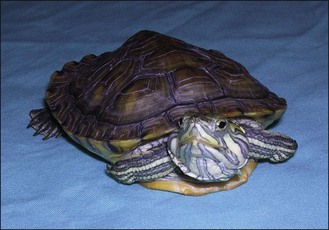21 Aural abscesses in a map turtle
Introduction
CASE PRESENTING SIGNS
A juvenile male map turtle (Graptemys species) (Box 21.1) presented with bilateral swellings on its head.
BOX 21.1 Ecology of map turtles
• Normal habitat: semi-aquatic, freshwater (ponds, river-bottoms and lakes). Prefer large aquatic bodies, with areas of fallen trees or other debris for basking. Several animals may congregate to bask
• Average size: adult male = 10–25 cm in length, female = 18–27 cm in length, with weight 0.5–2.5 kg
• Sexual dimorphism: female much larger than male. Carapace more oval in males, who also have longer fore claws and a longer thicker tail (to contain the phallus)
• Reproduction: mating in deep waters, nesting (May–July) in unshaded sites with sandy soil. Clutch size = 6–20 eggs. Incubation = 50–70 days. Temperature-dependent sex determination
• Free-ranging diet: omnivorous, mainly feeding in water. Invertebrates such as aquatic insects, snails, crayfish and smaller crustaceans, also dead fish and plant material. The smaller male eats mainly insects, while the female consumes more molluscs and crustaceans. Older animals eat more plant material (<50% diet)
• Captive diet: animal material (70%) – rehydrated low-fat dried cat/dog/trout pellets, small raw fish, bloodworms, earthworms; fresh food (30%) – leafy green vegetables and aquatic plants
Clinical Examination
The map turtle was examined; findings included:
• Moving around well, with no locomotor problems. Supporting body weight, standing up on all four limbs. No limb swellings or discomfort were detected
• A firm swelling was present laterally on either side of the map turtle’s head, caudal to the eyes. The swelling on the right protruded approximately 4 mm while that on the left extended approximately 3 mm (Fig. 21.1)




